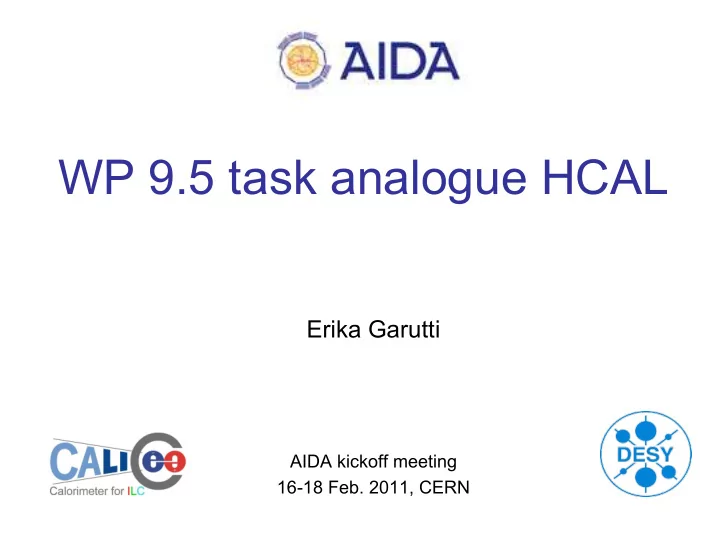

WP 9.5 task analogue HCAL Erika Garutti AIDA kickoff meeting 16-18 Feb. 2011, CERN
The Goal Advance tungsten as a realistic alternative to steel for the absorber structure of the hadronic calorimeter of the future linear collider detector • Validate shower simulations for tungsten – stronger role of neutrons than in iron – to be done with scintillator and gaseous devices • Gain engineering experience with tungsten • Develop electronics integration solution for a very compact HCAL • Study timing issues – physics: signals from delayed de-excitations – algorithms: tag neutron signals – operation: time stamping for background rejection 2
The group structure CERN optical test stand to assess time-stamping capabilities of active readout engineering of tungsten absorber structure MPI M test stand with a radioactive source for characterization of scint. tiles LAL highly integrated ASICs with independent ch.-by-ch. trigger and read-out U.Hei. SiPM ASIC (cooperation with LAL) with improved ToF measurements DESY multi-layer system integration, compact DAQ, calibration and power supply interfaces, and cooling U.Wup. scalable LED-Calibration system (collaboration with Bergen) Prague adaptive power supply system with temperature compensated bias voltage (collaboration with Bergen) Bergen SiPM voltage adjustment procedure and adaptive power supply Entering new: Uni. Mainz, Uni. Hamburg 3
AHCAL structure Signal sampled by scintillating tiles → 3x3x0.3cm 3 , 2592 tiles per layer Long term: Short term: Establish mass test of tiles commission HBU (tiles, ASIC, LED) Develop multi-layer DAQ 4-HBU test in hadronic shower Integration of electronics 4D hadronic shower study
Test beam – First MIP results HBU2 in DESY test beam • Test functionality in test beam environment • Measure MIPs with 2 GeV electron beam → ~15 pixels per MIP • Test channel-wise gain and autotrigger adjustment and optimize MIP efficiency → Good results 0.5 MIP cut, tuned PA feedback capacities 5
Mass test of tile production Heidelberg 450 + 470 tiles delivered to DESY of which 144 tiles to Heidelberg for characterization è Enough for 4 HBU 6
New HCAL Base Unit (HBU2) 7
Power pulsing DESY 8
LED calibration system Wuppertal solution: Light directly coupled into tile by 1 integrated LED per channel Light output equalization via C1 – C3 (default: 150pF, plus: 22pF, 82pF) New design implemented in HBU2 and is currently tested extensively Prague solution: Light coupled into tile by notched fiber Mechanical integration difficult → First tests performed in DESY lab with new electronics and new tiles 9
Embedded LED calibration system DESY/Wuppertal LED light output equalization: 4 bias capacitor combinations tested: → 150pF, 172pF, 252pF and 254pF Measured minimum voltage to produce LED light → Improvement of LED uniformity possible! SiPM saturation: SiPM saturation can be seen with the integrated LED system 10
Combined test with HBU2 and QMB1 Prague • HBU2 (two SPIRoc2b ASICs) equipped with 3 rows of scintillators with SiPMs (delivered in Nov2011) • 3 active QMB1s 3mm UV LED (395nm) • Tested with new notched-fibre prototypes (semi-automatic production) 3x noteched fibre 3x QMB1 Bad channels 11
Results Prague • Single Photo-electron Spectrum obtained for all channels by a single run • Saturation of the SiPM observed 12
SPIROC 2 - time measurements DESY/LAL SPIROC2b measures time in auto-trigger mode relative to bunch clock → 2 ramps to reduce deadtime due to ramp reset → ILC mode = 200ns ramp, testbeam mode = 5µs ramp (less dead time) → Investigate time resolution to optimize ramp slopes (and lengths) → time resolution of ASIC tested: ILC mode = 300ps, testbeam mode = 1-2ns 13
Simulation DESY/Uni HH Implementation of time information in simulation done ✔ Digitization is currently under development → Realistic analyses of simulation data with timing information started → Prepare for future 4D testbeam measurements 10 GeV pions QGSP_BERT_HP 10 GeV pions QGSP_BERT • difference between models > 1 ns (ASIC resolution) in every layer • smaller difference in last layers 14
Preparing for test beam (SPS) Planned test beam time at SPS in Nov. ’12 → 4-HBU-Cassette in production → Side-Interface-Board in development → Extender board in development → DIF redesign ongoing → simulation studies ongoing 15
Towards direct coupling Uni HH/ Munich Tiles produced at UniHH using Munich direct coupling design High uniformity Simplified assembly procedure sufficient LY with paper wrap Ketek (Type II) 2.25 mm x 2.25 mm area (12000 cells, pitch 20 µm) 16
Towards a complete system Uni Mainz
Conclusions / outlook • AIDA work package 9.5 AHCAL is progressing according to schedule • Test of power pulsing and electronics in a 2m long calorimeter layer in preparation at DESY • Getting ready for first 4D hadronic shower measurements at SPS in fall this year – All critical components under development or test EUDET vertical – Need to intensify activity on DAQ test structure development/adaptation • Progress towards a calorimeter stack 18
19
Recommend
More recommend